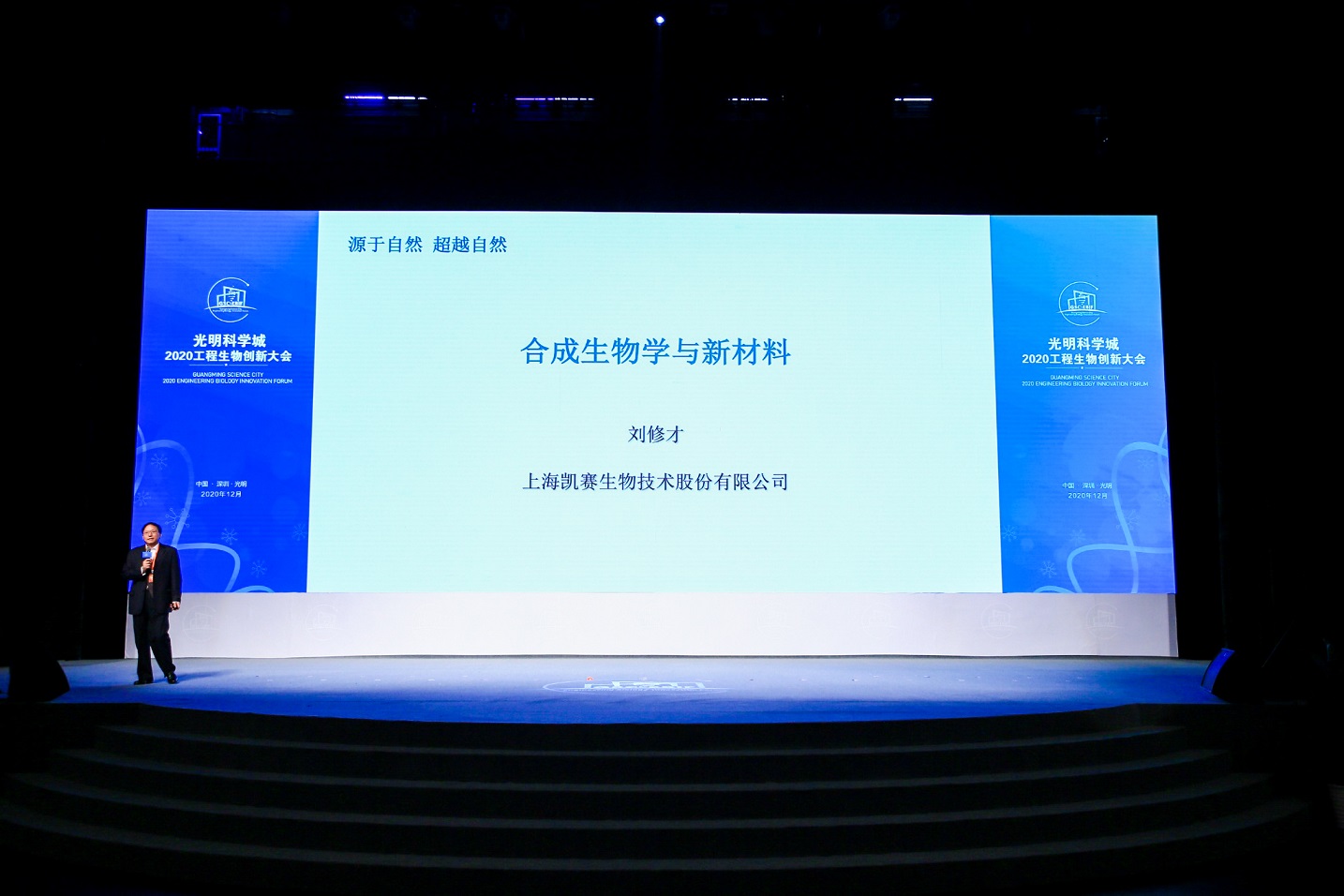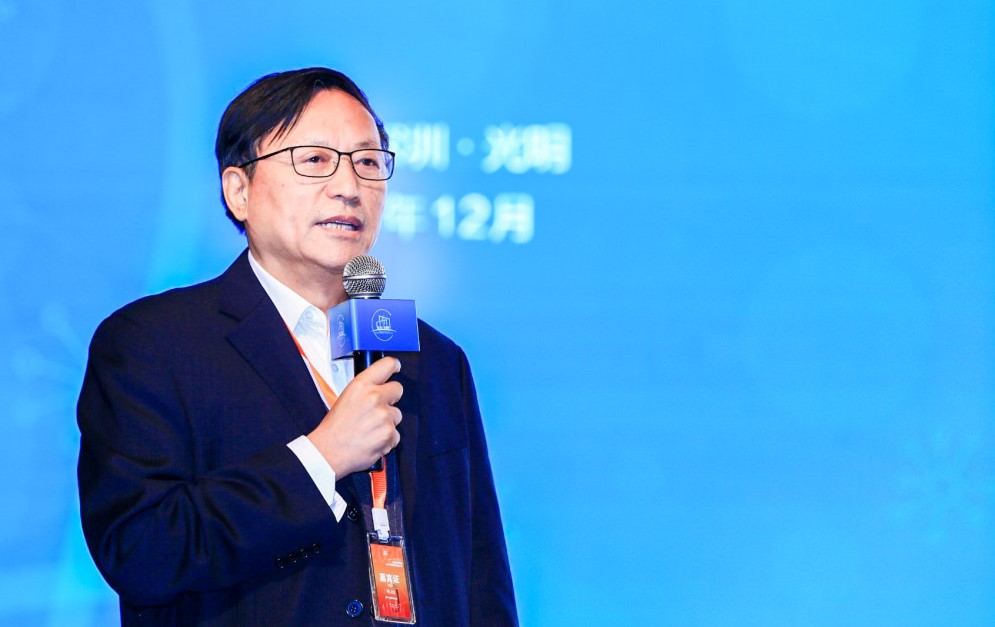Liu Xiucai: The production of biomaterials needs to start from 2 challenges such as renewable raw materials and recyclable products, and with competitive cost
Source: 生辉SciPhiPublisher: CathayDate: 2020-12-23Read: 2174
December 19-20, 2020, sponsored by ‘Development and Reform Commission of Shenzhen Municipality’ and ‘the Guangming District People's Government’, presented by ‘Shenzhen Institutes of Advanced Technology, Chinese Academy of Sciences’, ‘the Chinese Academy of Sciences Shenzhen Polytechnic University (Preparatory)’, ‘Shenzhen Institute of Synthetic Biology’, ‘DeepTech’, ‘Shenke (Shenzhen) Engineering Biotech Co., Ltd.’, co-organized by ‘Synthetic Biology Professional Committee, Chinese Society of Biotechnology’, ‘Synthetic Biotechnology Branch, China Pharmaceutical Biotechnology Association’, ‘Shenzhen Association of Synthetic Biology’, Guangming Science City·2020 Engineering Biology Innovation Forum • Finals of China Life Sciences Entrepreneurship Competition of
On the same day, Liu Xiucai, chairman of Cathay Biotech, attended the meeting and delivered a speech entitled "Synthetic Biology and New Materials". Here's a transcript of the speech.
Good morning, everyone! Thanks for the invitation. I would like to share with you today the methods of synthetic biology and new materials through two aspects. Firstly, the relationship between synthetic biology and innovation of new materials and secondly, the development process of Cathay Biotech in R&D industrialization of biology and new materials.
Global carbon emissions mainly come from energy consumption and material use. The consumption is about 500 million tons of polymer materials each year worldwide. There is a release of between 8-9 tons of carbon dioxide for each ton of material. As a result, carbon dioxide released by the use of polymer materials is high, reaching between 4 billion - 5 billion tons, which poses a great problem for the environment and the sustainable development of our Earth. In 2004, the U.S. Department of Energy introduced 12 series of basic chemical raw materials. They can be replaced by biological methods. International chemical companies, the materials and the agricultural industry are trying to make basic chemical raw materials with synthetic biology methods. The efforts of many companies in the production of different materials have given hope to the capital markets although some setbacks have occurred.
In recent years, capital markets have begun to pay attention to the biological industry. Let me introduce two examples. The market capitalization of BEAM Therapeutics last week was $4.5 billion, and Beyond Meat, a company focused on artificial meat, is now worth more than $8.6 billion.
Recently, rapid progress has been made in synthetic biology. I personally think there are two reasons. Firstly, due to the active promotion from the science area. The ‘Shenzhen Institute of Synthetic Biology’ and the ‘Tianjin Industrial Microorganism Research Institute’ have done a lot of work, and scientific professionals have made a big effort. Secondly, environmental pressure and policy. In September 2020, the state announced that China aims to achieve carbon neutrality by 2060. On December 12th the country again announced detailed targets for carbon dioxide emissions and non-fossil energy at the Climate Ambition Summit 2020.
The EU's measures on carbon emissions are very specific. The document released on March 11th is very valuable to the industry, specifying how carbon emissions are managed. These specific regulations have led to a gradual decline in the competitiveness of the traditional chemical industry relative to the bio-manufacturing industry, opening up new opportunities for the biosynthetic industry.
Looking back on the history of human development, after the Stone Age, the Bronze Age and the Iron Age to now, next is the age of biology. The advent of the biological age is, on the one hand, to meet the needs of sustainable development of human beings, and, more importantly, to enable organisms to complete production substitutions as biotechnology continues to advance. Substitution focuses mainly on two directions, one is the function of replacing the existing chemical polymer materials, the other is to replace inorganic materials from the point of energy saving.
There are two difficult problems of bio-manufacturing materials to be solved, I think renewable raw materials and product recycling are our challenge. It’s far from enough for synthetic organisms to rely on the contribution of environmental protection. The most important thing is to make the cost competitive, especially in the competition with petrochemical materials. Biomaterials stand a chance only if their cost is competitive.
First of all, there are several options for biological materials. One is the realization of simple substitution or similar product substitution based on synthetic biology. Biological methods need to be more cost-effective, more competitive.
From material concepts to products and markets, this process is divided into two large stages. Firstly, the process of monomer research and industrialization. Products are synthesized directly within the cell (synthetic organisms). I think people work a lot on genetic engineering editing, but in practice, product separation and purification are often a bigger challenge. Secondly, the challenge of new material applications. Applied biological materials have not yet become mainstream. In material polymerization, bio fermentation and so on, there’re still a lot of resistance for the new materials to enter the market. In addition to performance development, the resistance generated by the user side also needs attention.
Cathay chose bio-based polyamide as one of our products and has successfully made the Nylon 510 using biological methods. It has successfully been applied to cell phone holders, clothing and food packaging films.
The core of the entire bio-based polyamide imitation protein is the imitation of the carbon structure. After that people added aromatic compounds and a benzene ring into the structure. Taking the semi-aromatic family as an example, after the introduction of benzene rings, 20 groups can form a flat structure which greatly improves mechanical performance.
After more than 80 years of industrialization, two families, semi-aromatic and fatty, have been formed. From Nylon 66 to Nylon 46 to Long Chain Nylon 12 and Nylon 11. Among non-aromatic materials, Nylon 46 is more expensive and Nylon 6 is the lowest. From a biological point of view, I think there are several production options, one is to imitate Nylon 6 from the angle of monomer and produce lactam by biological methods. We explored this more than a decade ago but found that biological methods are not as efficient as chemical methods.
Over the past 20 years, the main use of biological methods is to produce amino, carboxy-based compounds and polymer monomers. In addition to being able to synthesize a series of polyamides to replace traditional nylon, the main goal is to "replace steel with plastic", to become the real bulk material. This market will have unlimited possibilities in the direction of materials.
Let me introduce the long chain acid. It took us nearly 20 years to replace the market for product made with chemical methods. The process of substitution mainly includes two angles. Firstly, construction of a simple synthetic transformation process and secondly, by cleaning up the entire biological system. The shorter the synthesis route, the better. The cheaper the raw material, the better.
We are also expanding our products, developing binary acid containing 10 carbons. As the carbon number decreases, the inhibitory effect of organisms will be enhanced. So, we need to overcome this problem in the process of genetic modification.
Secondly, purification challenges. The purification problem of sebacic acid products with chemical methods has always plagued the production of Nylon 610. Now it is proved that biological methods can be very successful.
On this basis, we use a new technology to make long chains into "ultra-long chains", and thus replace Nylon 11, Nylon 12 and other particularly high value-added products. It contains wear resistance and mechanical behavior under high temperature which are the two most critical factors to produce long-chain nylon. We hope to replace the traditional application market scope of long-chain diacids. The most important thing is to construct new functions and significantly reduce costs.
Polyamide production must use binary amine, now the number of carbon atoms of binary amine is almost even, the only odd carbon is the nine carbon binary amine which has a particularly high cost. It’s very important for the entire polyamide industry to construct an odd carbon diamine with low cost. Biological methods can be produced through the role of lysine dehydrase. Cathay Biotech has solved this problem.
Based on industrial diamine production technology, we have produced a range of bio-based polyamides that can be a perfect substitute for all nylon produced by chemical methods.
Hereby 3 examples of our 3 products, 1273, 2260, and 6300. These 3 products have different melting points, moisture absorption and thermal variant temperatures. For example, in the applications development, moisture absorption is the most important indicator in the textile industry. TERRYL®, our bio-based polyamide brand, has moisture absorption and sweat releasing which are the best of all textile materials. We made a polyamide that can be directly melt-spun for the first time and greatly reduces the spinning cost.
Recently, light weighting has been the main point of industry development. But most of the focus are the materials that are non-recyclable plastics such as polyurethane, epoxy resin, PVC and so on. We made a recyclable lightweight material.
We've developed over 20 years on research. Our annual production has reached 70,000 tons in 2018, from 5,000 tons at the beginning. This year we just signed a contract to construct a megaton production site in the Shanxi province. The industrial park covers an area of 11 square kilometers. We hope to make a complete industrial chain of synthetic biology. Our goal is to build a zero-carbon industry park with clean energy. We hope to achieve 3 results, renewable raw materials, recyclable products and competitive cost.
Thank you!





